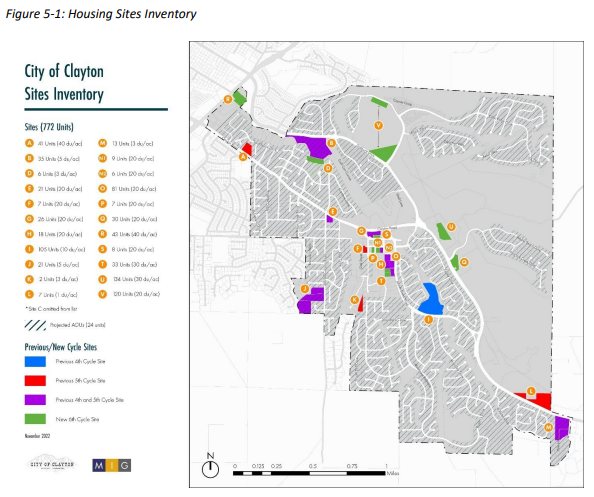Last night the Council met in special session (outside of our regular 1st and 3rd Tuesdays of the month) to conduct a study session on the latest draft of our Housing Element (HE). We are required to approve the HE by the end of January. The purpose of the study session was to go over in detail the draft, ask questions of staff, discuss the HE, and suggest any changes that may be desired prior to the planned adoption at our regular 1.17.23 meeting. As such, there were several questions and discussion items which I will try to summarize below. But first, the main point of the updated HE is to provide zoning for our allocated RHNA units of 570 across all income levels. Our draft HE contemplated 796 units across all income levels. The detail breaks out like this:
This image (found on page 98 of the agenda) shows the location of various sites where zoning is proposed to increase:
Three sites - Oakhurst Driving Range, Easley Ranch, and the hill sites at Eagle Peak represent approximately 43% of the total 796 units being upzoned. Of the 312 units being upzoned for Extremely Low, Very Low, and Low Income, 27% come from just two sites, the Presbyterian Church and St. John's Parish. Each of these sites were included to be upzoned based on discussion with property owners.
The first thing we discussed was the rationale for having a surplus. In other words, if the requirement was to zone for 570 units, why were we proposing to zone for 796, or 40% greater than the requirement?
There were a few reasons for this that staff discussed:
- Zoning for greater units allowed a buffer so that if HCD denied our analysis of some of the units, the HE could still be approved as it would have a sufficient number of increased units included.
- A buffer also allowed for various projects that were contemplated at a certain zoning density to actually be approved at lower densities. If we did not have a buffer, then any project approved at a lower density would then trigger a need to go back to HCD and have our HE approved all over again as State law requires that there be "no net loss" in zoning - once units are zoned they can effectively never decrease.
- Much of the Extremely Low, Very Low, and Low income housing units required that we have provided for are a result of other sites that also have Above Moderate income units. "Above Moderate" can be considered to be "market rate". The majority of the surplus in zoning for the HE consists of units in the Above Moderate category as seen in the above table, and several of those developments have other income category housing units connected with them. Without the large number of units in the Above Moderate income category we would be less likely to achieve the requirements for the other income categories.
- There was an advantage of having the HE approved more quickly - if there were a lot of back and forth then we would be forced to implement the changes contemplated in the HE more rapidly, within one year, vs. within three years if the HE is approved sooner rather than later.
Within the report sent to HCD for comment, they identified several areas that were considered to be potential constraints to housing development. Each of these needed to be addressed by the updated HE and we spent some time discussing them. Things like side setbacks, building height limits, covered parking requirements, length of time permits are in effect,, and public hearings for site plan review for residential improvements were all considered to be potential constraints to housing development and the HE included programs that committed to changing these rules within our city code and zoning.
HCD also requires the HE to discuss how the city affirmatively furthers fair housing, including racially concentrated areas of affluence. Part of that discussion included a history of housing in Clayton. The history section described how some of our current zoning came to be, saying, "... community and City Council
opposition, geographic constraints, zoning limitations, and community priorities have all contributed to
the current patterns of segregation seen in the City today."
To this statement I was opposed. I did not agree that the items mentioned caused patterns of segregation in the City today and stated that including this statement assumes facts that were not in evidence. I do think that past actions of the City have led to a bias in zoning towards single family zoning, but that alone is not sufficient to support the assertion that all of the other items mentioned have caused patterns of segregation in the City. Many people have come to Clayton because of the housing environment that Clayton provides which is predominantly within single family zoning, and decisions of the City and its elected leadership reflect that community interest.
Councilmember Tillman described removing this language as whitewashing. While she did not say whether she believed it to be true, Tillman asserted that there were individuals she was in contact with that felt that Clayton was a Sundown Town - municipalities or neighborhoods that practice a form of racial segregation by excluding non-whites via some combination of discriminatory local laws, intimidation or violence. While I acknowledged that some individuals may have that perception, the perception alone does not make it true.
We gave feedback to staff to update the language to be more objective and include primarily factual matters, along with some wordsmithing suggestions.
Our plan is to review the updated HE at our regular meeting on Tuesday, 1.17.23. Stay tuned for an update once that agenda is published.
There was also a Closed Session in which there were no reportable actions.

